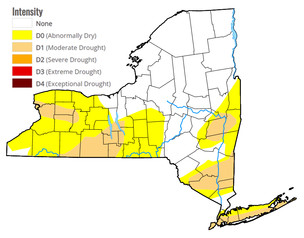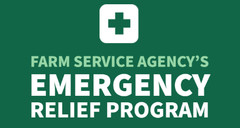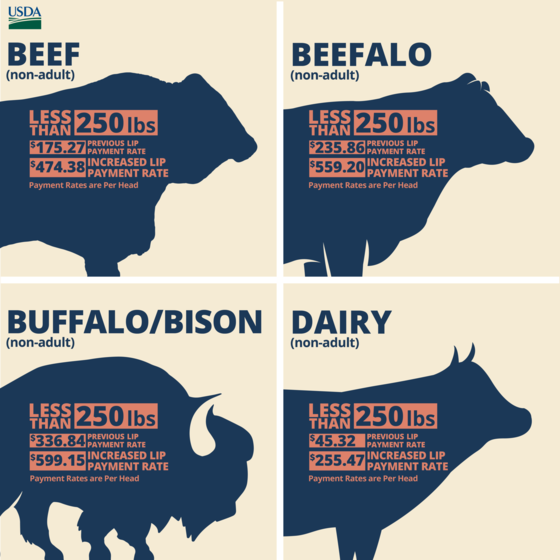|
July 22
Deadline extended
|
Emergency Relief Program (ERP) Phase One Deadline
|
|
Aug 15
|
Acreage Reporting Deadline for cabbage and beans
|
|
Sept 1
|
NAP Coverage Deadline for garlic
|
|
Sept 5
|
All Service Centers Closed for Labor Day
|
|
Sept 30
|
NAP Coverage Deadline for all perennial grasses, alfalfa, clover, and mixed forage; all small grains such as barley, oats, wheat, and rye; and value loss crops (aquaculture, Christmas trees, finfish, floriculture, ginseng root, ginseng seed, mollusk, mushrooms, and turf grass sod)
|
|
Sept 30
|
Acreage Reporting Deadline for value loss/controlled environment crops for subsequent year (except nursery). Includes Mollusk, Christmas trees, floriculture and turf grass sod.
|
|
Ongoing
|
Conservation Reserve Program (CRP) - Continuous Enrollment
|

This is likely no surprise to you, but drought persists across the western U.S. and is intensifying in some areas. No geographic area is immune to the potential of drought at any given time. The U.S. Drought Monitor provides a weekly drought assessment, and it plays an important role in USDA programs that help farmers and ranchers recover from drought.
Fact #1 - Numerous agencies use the Drought Monitor to inform drought-related decisions.
The map identifies areas of drought and labels them by intensity on a weekly basis. It categorizes the entire country as being in one of six levels of drought. The first two, None and Abnormally Dry (D0), are not considered to be drought. The next four describe increasing levels of drought: Moderate (D1), Severe (D2), Extreme (D3) and Exceptional (D4).
While many entities consult the Drought Monitor for drought information, drought declarations are made by federal, state and local agencies that may or may not use the Drought Monitor to inform their decisions. Some of the ways USDA uses it to determine a producer’s eligibility for certain drought assistance programs, like the Livestock Forage Disaster Program and Emergency Haying or Grazing on Conservation Reserve Program acres and to “fast-track” Secretarial drought disaster designations.
Fact #2 - U.S. Drought Monitor is made with more than precipitation data.
When you think about drought, you probably think about water, or the lack of it. Precipitation plays a major role in the creation of the Drought Monitor, but the map’s author considers numerous indicators, including drought impacts and local insight from over 450 expert observers around the country. Authors use several dozen indicators to assess drought, including precipitation, streamflow, reservoir levels, temperature and evaporative demand, soil moisture and vegetation health. Because the drought monitor depicts both short and long‐term drought conditions, the authors must look at data for multiple timeframes. The final map produced each week represents a summary of the story being told by all the pieces of data. To help tell that story, authors don’t just look at data. They converse over the course of the map-making week with experts across the country and draw information about drought impacts from media reports and private citizens.
Fact #3 - A real person, using real data, updates the map.
Each week’s map author, not a computer, processes and analyzes data to update the drought monitor. The map authors are trained climatologists or meteorologists from the National Drought Mitigation Center at the University of Nebraska-Lincoln (the academic partner and website host of the Drought Monitor), the National Oceanic and Atmospheric Administration and USDA. The author’s job is to do what a computer can’t – use their expertise to reconcile the sometimes-conflicting stories told by each stream of data into a single assessment.
Fact #4 - The Drought Monitor provides a current snapshot, not a forecast.
The Drought Monitor is a “snapshot” of conditions observed during the most recent week and builds off the previous week’s map. The map is released on Thursdays and depicts conditions based on data for the week that ended the preceding Tuesday. Rain that falls on the Wednesday just before the USDM’s release won’t be reflected until the next map is published. This provides a consistent, week‐to‐week product and gives the author a window to assess the data and come up with a final map.
Fact #5 – Your input can be part of the drought-monitoring process.
State climatologists and other trained observers in the drought monitoring network relay on-the-ground information from numerous sources to the US Drought monitor author each week. That can include information that you contribute.
The Drought Monitor serves as a trigger for multiple forms of federal disaster relief for agricultural producers, and sometimes producers contact the author to suggest that drought conditions in their area are worse than what the latest drought monitor shows. When the author gets a call like that, it prompts them to look closely at all available data for that area, to see whether measurements of precipitation, temperature, soil moisture and other indicators corroborate producer-submitted reports. This is the process that authors follow whether they receive one report or one hundred reports, although reports from more points may help state officials and others know where to look for impacts.
There are multiple ways to contribute your observations:
-
Talk to your state climatologist - Find the current list at the American Association of State Climatologists website.
-
Email - Emails sent to droughtmonitor@unl.edu inform the USDM authors.
-
Become a CoCoRaHS observer - Submit drought reports along with daily precipitation observations to the Community Collaborative Rain, Hail & Snow Network.
-
Submit Condition Monitoring Observer Reports (CMOR) - go.unl.edu/CMOR.
For more information, read our Ask the Expert blog with a NDMC climatologist or visit farmers.gov/protection-recovery.
|

The U.S. Department of Agriculture (USDA) announced that it will indefinitely extend the deadline for producers to return the pre-filled applications for Phase One of the Emergency Relief Program (ERP). A new deadline will be announced after the last Phase One applications are mailed and provide at least 30 days following the mailing.
Continuing to build on the initial mailing of pre-filled applications in May, the Department will continue using existing information in USDA and crop insurance files to send additional pre-filled applications starting this week for potentially eligible Noninsured Crop Disaster Assistance Program (NAP) participants. Once applications from eligible NAP producers are returned, these producers are expected to receive about $105 million in ERP payments for eligible losses from 2020 and 2021 disasters.
USDA’s Farm Service Agency (FSA) is now mailing pre-filled applications to NAP producers through ERP to offset crop yield and value losses. To receive a relief payment, producers should complete and return the applications by announced deadlines.
Producers are expected to receive assistance direct deposited into their bank account within three business days after they sign and return the prefilled application to the FSA county office and the county offices enters the application into the system.
While most crop insurance customers that may be eligible for ERP Phase One received the pre-filed applications in May, there are some who should expect to receive a form in August including:
- Producers who had an eligible loss in 2020 that had been recorded in the crop insurance records as a 2019 loss (e.g., prevented planting claims); and
- Producers with policies that required additional information before being able to calculate an indemnity for 2021 losses (producers with 2020 losses would have already received that application). Policies that required additional information include Supplemental Coverage Option (SCO), Enhanced Coverage Option (ECO), Stacked Income Protection Plan (STAX), Margin Protection Plan (MP) or Area Risk Protection Insurance (ARPI).
Producers without risk management coverage through crop insurance or NAP and those with shallow losses may be covered by the forthcoming Phase Two of ERP.
USDA estimates that Phase One ERP benefits will reach more than 5,200 producers with NAP coverage for eligible 2020 and 2021 crop losses. This emergency relief complements ERP assistance recently provided to more than 162,000 producers who had received crop insurance indemnities for qualifying losses. Nearly 13,000 additional crop insurance customers will also receive pre-filled applications in August to cover eligible 2020 losses described above and for producers with more complex policies where indemnities could not be calculated for 2021 previously.
ERP and the previously announced Emergency Livestock Relief Program (ELRP) are funded by the Extending Government Funding and Delivering Emergency Assistance Act, which President Biden signed into law in 2021. The law provided $10 billion to help agricultural producers impacted by wildfires, droughts, hurricanes, winter storms and other eligible disasters experienced during calendar years 2020 and 2021. Overall, USDA has already quickly disbursed over $6 billion dollars under ERP and ELRP with reduced paperwork for the producer and field offices.
For more information on ERP eligibility, program provisions for socially disadvantaged or historically underserved producers as well as Frequently Asked Questions, NAP applicants can visit FSA’s Emergency Relief webpage and program fact sheet.
Additional USDA disaster assistance information can be found on farmers.gov, including the Disaster Assistance Discovery Tool, Disaster-at-a-Glance fact sheet and Farm Loan Discovery Tool. For FSA and Natural Resources Conservation Service programs, producers should contact their local USDA Service Center. For assistance with a crop insurance claim, producers and landowners should contact their crop insurance agent.
|

At USDA, we are committed to helping farmers complete loan applications, environmental reviews, and other paperwork free of charge. One-on-one support is available at more than 2,300 USDA Service Centers nationwide. USDA’s Farm Service Agency and Natural Resources Conservation Service staff are usually co-located at these Service Centers and can help guide farmers to the best USDA assistance based on their unique goals, whether it is loans, conservation programs, or insurance.
Service Center staff can guide farmers through the process of preparing and submitting required paperwork on their own, with no need to hire a paid preparer. Language translation service is available in all USDA Service Centers, so one-on-one assistance with a Service Center employee can be translated in real time for farmers requiring it. And while some program and loan applications do have an administrative fee for filing, there is never a charge for preparation services provided by USDA staff.
Farmers who work with the USDA Service Center can:
- Establish their farm by registering for a farm number, which is required for USDA programs and assistance.
- Learn how to meet conservation compliance provisions.
- Verify eligibility for USDA programs.
- Discuss their business and conservation goals.
- Create a conservation plan.
- Fill out and file loan and program applications.
We are committed to delivering USDA programs and services to America’s farmers and ranchers while taking safety measures in response to COVID-19. We encourage you to check the status of your local USDA Service Center and make an appointment to discuss your business needs.
|

The Farm Service Agency’s (FSA) Farm Storage Facility Loan (FSFL) program provides low-interest financing to help you build or upgrade storage facilities and to purchase portable (new or used) structures, equipment and storage and handling trucks.
Eligible commodities include corn, grain sorghum, rice, soybeans, oats, peanuts, wheat, barley, minor oilseeds harvested as whole grain, pulse crops (lentils, chickpeas and dry peas), hay, honey, renewable biomass, fruits, nuts and vegetables for cold storage facilities, floriculture, hops, maple sap and syrup, rye, milk, cheese, butter, yogurt, meat and poultry (unprocessed), eggs, and aquaculture (excluding systems that maintain live animals through uptake and discharge of water). Qualified facilities include grain bins, hay barns and cold storage facilities for eligible commodities.
Loans up to $50,000 can be secured by a promissory note/security agreement, loans between $50,000 and $100,000 may require additional security, and loans exceeding $100,000 require additional security.
You do not need to demonstrate the lack of commercial credit availability to apply. The loans are designed to assist a diverse range of farming operations, including small and mid-sized businesses, new farmers, operations supplying local food and farmers markets, non-traditional farm products, and underserved producers.
For more information, contact your local USDA Service Center or visit fsa.usda.gov/pricesupport.
|

The Farm Service Agency’s (FSA) Noninsured Crop Disaster Assistance Program (NAP) helps you manage risk through coverage for both crop losses and crop planting that was prevented due to natural disasters. The eligible or “noninsured” crops include agricultural commodities not covered by federal crop insurance.
You must be enrolled in the program and have purchased coverage for the eligible crop in the crop year in which the loss incurred to receive program benefits following a qualifying natural disaster.
NAP Buy-Up Coverage Option
NAP offers higher levels of coverage, from 50 to 65 percent of expected production in 5 percent increments, at 100 percent of the average market price. Buy-up levels of NAP coverage are available if the producer can show at least one year of previously successfully growing the crop for which coverage is being requested.
Producers of organics and crops marketed directly to consumers also may exercise the “buy-up” option to obtain NAP coverage of 100 percent of the average market price at the coverage levels of between 50 and 65 percent of expected production.
NAP basic coverage is available at 55 percent of the average market price for crop losses that exceed 50 percent of expected production.
Buy-up coverage is not available for crops intended for grazing.
NAP Service Fees
For all coverage levels, the NAP service fee is the lesser of $325 per crop or $825 per producer per county, not to exceed a total of $1,950 for a producer with farming interests in multiple counties.
NAP Enhancements
Beginning, limited resource and targeted underserved farmers or ranchers remain eligible for a waiver of NAP service fees and premium reduction when they file form CCC-860, “Socially Disadvantaged, Limited Resource and Beginning Farmer or Rancher Certification.”
For NAP application, eligibility and related program information, contact your local USDA Service Center or visit fsa.usda.gov/nap.
|

FSA guaranteed loans allow lenders to provide agricultural credit to farmers who do not meet the lender's normal underwriting criteria. Farmers and ranchers apply for a guaranteed loan through a lender, and the lender arranges for the guarantee. FSA can guarantee up to 95 percent of the loss of principal and interest on a loan. Guaranteed loans can be used for both farm ownership and operating purposes.
Guaranteed farm ownership loans can be used to purchase farmland, construct or repair buildings, develop farmland to promote soil and water conservation or to refinance debt.
Guaranteed operating loans can be used to purchase livestock, farm equipment, feed, seed, fuel, farm chemicals, insurance and other operating expenses.
FSA can guarantee farm ownership and operating loans up to $1,825,000. Repayment terms vary depending on the type of loan, collateral and the producer's ability to repay the loan. Operating loans are normally repaid within seven years and farm ownership loans are not to exceed 40 years.
For more information on guaranteed loans, contact your local USDA Service Center at or visit fsa.usda.gov.
|

The U.S. Department of Agriculture (USDA) is accepting offers for more than 3.1 million acres from agricultural producers and private landowners through this year’s Conservation Reserve Program (CRP) Grassland Signup, the highest in history. The signup’s results include nearly 2,000 acres in New York. This program allows producers and landowners to continue grazing and haying practices while protecting grasslands and promoting plant and animal biodiversity and conservation, and it’s part of the Biden-Harris administration’s broader effort to address climate change and to conserve natural resources.
Nationwide, this year’s Grassland CRP signup surpassed last year’s 2.5 million acres by 22%. So far this year, producers have enrolled 2 million acres through the General Signup and more than 464,000 acres have been submitted through the Continuous CRP Signup. This means about 5.6 million acres are entering CRP in 2023, surpassing the 3.9 million acres expiring this year.
Because Grassland CRP supports not only grazing operations but also biodiversity and conserving environmentally sensitive land such as that prone to wind erosion, USDA’s Farm Service Agency (FSA) created two National Priority Zones in 2021: the Greater Yellowstone Migration Corridor and Dust Bowl Zone. For this year’s signup, FSA expanded the Greater Yellowstone Wildlife Migration Corridor Priority Zone to include seven additional counties across Montana, Wyoming, and Utah, to help protect the big-game animal migration corridor associated with Wyoming elk, mule deer and antelope. FSA accepted offers on more than 1.4 million acres in these two zones.
Grasslands enrolled in CRP help sequester carbon in vegetation and soil, while enhancing resilience to drought and wildfire. Meanwhile, producers can still conduct common grazing practices, such as haying, mowing, or harvesting seed from the enrolled land, which supports ag production.
Broadening Reach of Program
As part of the Agency’s Justice40 efforts, producers and landowners who are historically underserved, including beginning farmers and military veterans, will receive 10 additional ranking points to enhance their offers. From more than 5,000 underserved producers, USDA accepted offers of more than 1.9 million acres, about 87% of those who submitted applications.
Additionally, USDA is working to broaden the scope and reach of Grassland CRP by leveraging the Conservation Reserve Enhancement Program (CREP) to engage historically underserved communities. CREP is a partnership program that enables states, Tribal governments, and non-profit entities to partner with FSA to implement CRP practices and address high priority conservation and environmental objectives. Interested entities are encouraged to contact FSA.
Producers can still make an offer to participate in CRP through the Continuous CRP Signup, which is ongoing, by contacting the FSA at their local USDA Service Center.
|
Farmers can use USDA farm ownership microloans to buy and improve property. These microloans are especially helpful to beginning or underserved farmers, U.S. veterans looking for a career in farming, and those who have small and mid-sized farming operations.
Microloans have helped farmers and ranchers with operating costs, such as feed, fertilizer, tools, fencing, equipment, and living expenses since 2013.
Microloans can also help with farmland and building purchases and soil and water conservation improvements. FSA designed the expanded program to simplify the application process, expand eligibility requirements and expedite smaller real estate loans to help farmers strengthen their operations. Microloans provide up to $50,000 to qualified producers and can be issued to the applicant directly from the USDA Farm Service Agency (FSA).
To learn more about the FSA microloan program, contact your local USDA Service Center or visit fsa.usda.gov/microloans.

Learn more and register for a free webinar
FSA is investing in two outreach and education efforts for farmers and ranchers, including those who are new to agriculture or who have been historically underserved by programs.
First, FSA is announcing $10 million in the new Taxpayer Education and Asset Protection Initiative. Through this initiative, FSA has partnered with the University of Arkansas and the National Farm Income Tax Extension Committee to deliver tax education resources for farmers and ranchers, which includes engagement with agricultural educators, and tax professionals through partnerships with community groups and minority serving institutions across the country.
Second, FSA is investing $4.5 million in outreach for the Conservation Reserve Program Transition Incentives Program (CRP TIP), which increases access to land for new farmers and ranchers. FSA will award cooperative agreements to 15 to 20 partner and stakeholder organizations to conduct outreach and technical assistance and promote awareness and understanding among agricultural communities, particularly those who are military veterans, new to farming, or historically underserved.
Learn more and register for a free webinar on tax preparation.
|
As a former rancher myself, I know the tremendous investments—in time, sweat, and thought—that producers make even before their calves hit the ground. My experiences lead me to firmly believe that, here at the Farm Service Agency (FSA), we must find flexibilities where possible to help our farmers and ranchers best meet the challenges of the day.
In recent meetings with Senator John Hoeven, FSA North Dakota State Executive Director Marcy Svenningsen, and livestock producers in North Dakota impacted by catastrophic 2021 winter storms, it became apparent that our Livestock Indemnity Program (LIP) payment rates were not reflective of the true market value for non-adult beef, beefalo, bison, and dairy animals. It was time for us to pivot.
LIP provides benefits to livestock owners and some contract growers for livestock deaths exceeding normal mortality from eligible adverse weather events, certain predation losses and reduced sales prices due to injury from an eligible loss.
Indemnity payments are made at a rate of 75 percent of the market value of the livestock on the day before the date of death. I don’t mind saying that, under our previous payment rates, cutting a LIP check to a rancher for $150 for a calf in today’s market came nowhere near covering the year-long investment in carrying the cow through pregnancy and carrying the calf from birth to sale.
To better capture ranchers’ investments in their animals, we recently announced increased LIP payment rates for beef, beefalo, bison, and dairy animals less than 250 pounds. These now-updated payment rates are reflective of the substantial increased cost of these non-adult livestock in 2022:
 The updated LIP payment rates are effective immediately and will be applied retroactively starting January 1, 2022, for all eligible causes of loss including excessive heat, tornado, winter storms, and other qualifying natural disasters. Producers who have already received LIP payments for 2022 will receive an additional payment, if applicable, commensurate with these updated rates. For details on eligibility and payment rates, you can review our LIP fact sheet.
Other Program Improvements
These LIP policy changes complement enhancements we recently made to our Emergency Assistance for Livestock, Honey Bees and Farm-Raised Fish Program (ELAP) – changes that also were derived from the direct input and feedback of producers and the livestock groups.
In addition to paying above normal costs for hauling water to drought-stricken livestock, we also added compensation for hauling feed to livestock and livestock to forage or other grazing acres. And, in 2021, we added fish raised for food as an ELAP-eligible commodity because producers and industry leaders expressed the need.
By continually evaluating how we can deliver our programs in a manner that is meaningful to the farmers and ranchers we serve, we demonstrate our ongoing commitment to stakeholder engagement and our dedication to improving programs for livestock producers first signaled by Agriculture Secretary Tom Vilsack during a Senate Agriculture Committee hearing earlier this year.
It has been said actions speak louder than words, but when it comes to FSA programs that directly affect producers’ livelihoods and way of life and ultimately impact food security for all Americans, I believe the two are not mutually exclusive. Rest assured that when producers and producer groups speak, FSA and I, to the extent possible, will do whatever is within our power to turn those words into actions.
|